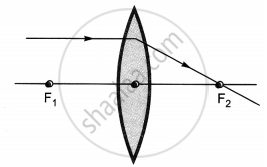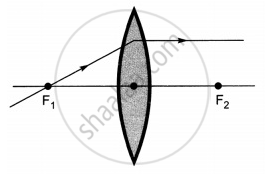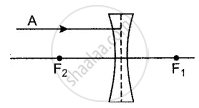Advertisements
Advertisements
प्रश्न
Explain the working of an astronomical telescope using refraction of light.
उत्तर
The astronomical telescope consists of two lenses: objective and eyepiece. Objective has larger focal length and diameter to accommodate maximum amount of light coming from the far away (astronomical) objects. A parallel beam of rays from an astronomical object is made to fall on the objective lens of the telescope. It forms a real, inverted and diminished image A'B' of the object. The eyepiece is so adjusted that A'B' lies just at the focus of the eye piece. Therefore, a highly magnified image of the object is formed at infinity. The same has been shown in the figure below.
APPEARS IN
संबंधित प्रश्न
Define the principal focus of a concave lens.
State whether concave lens has a real focus or a virtual focus.
Which type of lenses are:
thinner in the middle than at the edges?
Give the position, size and nature of image of formed by a concave lens when the object is placed:
at infinity.
A beam of light is incident through the holes on one side of a box and emerges out through the holes on its opposite side as shown in the following figure:
The box contains:
(a) a glass prism
(b) a concave lens
(c) a convex lens
(d) a parallel-sided glass slab
An object is placed at a distance of 4 cm from a concave lens of focal length 12 cm. Fine the position and nature of the image.
A concave lens of 20 cm focal length forms an image 15 cm from the lens. Compute the object distance.
State whether the following statement is true or false:
Short-sightedness can be cured by using a concave lens.
A person finds difficulty in seeing nearby objects clearly. His vision can be corrected by using spectacles containing:
(a) converging lenses
(b) diverging lenses
(c) prismatic lenses
(d) chromatic lenses
An object is placed on the axis of a lens. An image is formed by refraction in the lens. For all positions of the object on the axis of the lens, the positions of the image are always always between the lens and the object Draw a ray diagram to show it.
An object is placed on the axis of a lens. An image is formed by refraction in the lens. For all positions of the object on the axis of the lens, the positions of the image are always always between the lens and the object.State three characteristics of the image.
The power of a lens is negative. State whether it is convex or concave.
The diagrams showing the correct path of the ray after passing through the lens are:
 |
 |
| I | II |
 |
 |
| III | IV |
An object of height 4 cm is kept at a distance of 30 cm from a concave lens. Use lens formula to determine the image distance, nature and size of the image formed if focal length of the lens is 15 cm.
Choose the correct alternative and rewrite the following:
Inside water, an air bubble behaves ....................
When an object is kept within the focus of a concave mirror, an enlarged image is formed behind the mirror. This image is :
State three characteristics of the image of an extended source, formed by a concave lens.
In figure give below of thin concave lens, F1 and F2 are its foci, complete the path of the given ray of light after it emerges out of the lens.

Distinguish between Concave lens and Convex Lens.
